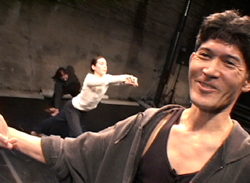by Mike Telin

On Saturday, May 7 at 8:00 pm in E.J. Thomas Hall, Christopher Wilkins will lead the Akron Symphony in Orff’s powerful score, featuring Shimotakahara’s new choreography performed by GroundWorks Dance Theater. The program will also include Leonard Bernstein’s Symphonic Suite from On the Waterfront.
Shimotakahara likened his task of creating the dance to putting together a large puzzle, not only on the creative side but also the logistical side. With all of the musicians and singers onstage, including the 45-member Cleveland Orchestra Children’s Chorus, how much room would be left for the 24 dancers in GroundWorks student and professional ensembles? Part of that problem was solved by locating the Akron Symphony Chorus on scaffolding above the orchestra.
“In terms of real estate, it was figuring out who needed to be onstage when,” Shimotakahara said during a recent telephone conversation. “But I have to say I think we’ve got it. I’m very excited about this production because I think it serves the music in a great way. The dance adds another dimension visually to what people experience when they hear this music, which gets your blood going.”
Shimotakahara said that he finds the work’s overarching themes of change and fate stimulating. The individual poems, whether in Latin, Middle-High German, or Old French, presented him with a wealth of ideas, although he didn’t try to replicate their meaning.
The choreographer said that as much as the soprano represents fortune, the solo baritone represents everyman. “His arias are always about questions. They’re full of doubt and angst about love and missed love, and ‘Was it worth it?’ As you age, you do look back and ask what you could have or should have done, and there are two ways of looking at that. You can get hung up and become bitter, or you can say that actually you did what you could. I think we all have to come to terms with that. I found that a great way to think about the piece was to look at as life experience, with all its joy and all its sorrow, and say yes, it’s good and it’s bad, and isn’t that amazing.”
Although Shimotakahara delved into the psychology of the poems, he was clear that the audience should not feel like they need to do the same. “The piece is full of wonderful tunes and rhythms. It’s the musical power and the beautiful mixture of the primal and ethereal that make it captivating for so many people. It’s got a really great energy about it, and the tension in it creates great drama. I hope we’ve captured that through the movement and the staging.”
Shimotakahara said he is grateful to once again have the opportunity with his GroundWorks Dance Theater to collaborate with the Akron Symphony. “We could never have undertaken this kind of thing on our own. It’s been wonderful to pull all of the partners together to make it happen. That’s a good thing, a very good thing.”
Published on ClevelandClassical.com May 2, 2016.
Click here for a printable copy of this article



